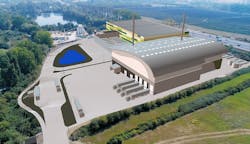Waste Management firm building 40-MW CHP Energy Recovery facility in the UK
Waste management services firm J Mould (Reading) will set up an Energy Recovery Center and an adjacent data center at its existing waste management facility off Berrys Lane, Reading in the United Kingdom.
This center will process up to 150,000 tons of waste material per annum and produce nearly 40 MW in combined heat and power (CHP) capacity.
Approximately 1 MW of the electrical output will be used at the site itself, including charging EVs and powering the data center. About 10 MW will be fed back to the National Grid.
Approximately 28 MW of thermal output from the Energy Recovery Center will be used in the data center’s cooling system.
At J Mould’s existing site, the waste management activities on one part of the site will cease and be replaced by this new £80 million facility.
The development of the on-site Energy Recovery Center will reduce the pollution associated with the transportation of the residual waste material. It will facilitate energy recovery of valuable material, which would otherwise end up in landfills. It will further contribute to the development of low carbon energy and help UK decarbonize energy generation by offsetting the use of fossil fuels.
About the Author
EnergyTech Staff
Rod Walton is senior editor for EnergyTech.com. He has spent 17 years covering the energy industry as a newspaper and trade journalist.
Walton formerly was energy writer and business editor at the Tulsa World. Later, he spent six years covering the electricity power sector for Pennwell and Clarion Events. He joined Endeavor and EnergyTech in November 2021.
He can be reached at [email protected].
EnergyTech is focused on the mission critical and large-scale energy users and their sustainability and resiliency goals. These include the commercial and industrial sectors, as well as the military, universities, data centers and microgrids.
Many large-scale energy users such as Fortune 500 companies, and mission-critical users such as military bases, universities, healthcare facilities, public safety and data centers, shifting their energy priorities to reach net-zero carbon goals within the coming decades. These include plans for renewable energy power purchase agreements, but also on-site resiliency projects such as microgrids, combined heat and power, rooftop solar, energy storage, digitalization and building efficiency upgrades.
